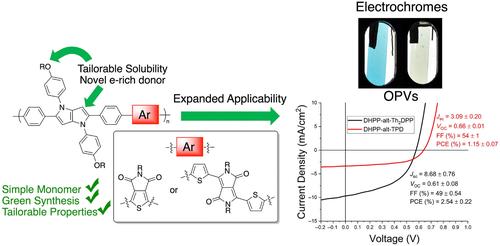当前位置:
X-MOL 学术
›
J. Polym. Sci.
›
论文详情
Our official English website, www.x-mol.net, welcomes your
feedback! (Note: you will need to create a separate account there.)
Synthesis of 1,4-dihydropyrrolo[3,2-b]pyrrole-containing donor–acceptor copolymers and their optoelectronic properties
Journal of Polymer Science ( IF 3.9 ) Pub Date : 2024-04-18 , DOI: 10.1002/pol.20240093 Kenneth‐John J. Bell 1 , Sina Sabury 2 , Vanessa Phan 1 , Ethan M. Wagner 1 , Allison M. Hawks 1 , Kimberley A. Bartlett 1 , Graham S. Collier 1, 3
Journal of Polymer Science ( IF 3.9 ) Pub Date : 2024-04-18 , DOI: 10.1002/pol.20240093 Kenneth‐John J. Bell 1 , Sina Sabury 2 , Vanessa Phan 1 , Ethan M. Wagner 1 , Allison M. Hawks 1 , Kimberley A. Bartlett 1 , Graham S. Collier 1, 3
Affiliation

|
Donor–acceptor (D–A)-conjugated polymers have achieved promising performance metrics in numerous optoelectronic applications that continue to motivate studying structure–property relationships and discovering new materials. Here, the materials toolbox is expanded by synthesizing D–A copolymers where 1,4-dihydropyrrolo[3,2-b]pyrrole (DHPP) is directly incorporated into the main chain of D–A copolymers for the first time via direct heteroarylation polymerization. Notably, the synthetic complexity of DHPP-containing polymers coupled with thieno[3,2-b]pyrrole-4,6-dione (TPD) or 3,6-bis(2-thienyl)-2,5-dihydropyrrolo[3,4-c]pyrrole-1,4-dione (Th2DPP) comonomers is calculated to be lower compared to many common conjugated polymers synthesized via direct arylation. The electron-rich nature of DHPPs when coupled with TPD or DPP enables optoelectronic properties to be manipulated, evident by measuring distinctly different absorbance and redox properties. Additionally, these D–A copolymers demonstrate their potential in organic electronic applications, such as electrochromics and organic photovoltaics. The reported DHPP-alt-Th2DPP copolymer is the first DHPP-based colored-to-transmissive electrochrome and achieves power conversion efficiencies of ~2.5% when incorporated into bulk heterojunction solar cells. Overall, the synthetic accessibility of DHPP monomers and their propensity to participate in robust polymerizations highlights the value of establishing structure–property relationships of an underutilized scaffold. These fundamental attributes serve to inform and advance efforts in the development of DHPP-containing copolymers for various applications.
中文翻译:

1,4-二氢吡咯并[3,2-b]吡咯供体-受体共聚物的合成及其光电性能
供体-受体(D-A)共轭聚合物在众多光电应用中取得了有前景的性能指标,这些应用继续推动着结构-性能关系的研究和新材料的发现。在此,通过合成 D-A 共聚物扩展了材料工具箱,其中 1,4-二氢吡咯并[3,2-b]吡咯 (DHPP) 首次通过直接杂芳基化聚合直接掺入 D-A 共聚物的主链中。值得注意的是,含 DHPP 的聚合物与噻吩并[3,2-b]吡咯-4,6-二酮 (TPD) 或 3,6-双(2-噻吩基)-2,5-二氢吡咯[3,据计算,与通过直接芳基化合成的许多常见共轭聚合物相比,4-c]吡咯-1,4-二酮 (Th 2 DPP) 共聚单体含量较低。当与 TPD 或 DPP 结合时,DHPP 的富电子性质使得可以操纵光电特性,通过测量明显不同的吸光度和氧化还原特性可以看出这一点。此外,这些 D-A 共聚物展示了它们在有机电子应用中的潜力,例如电致变色和有机光伏。所报道的 DHPP-alt-Th 2 DPP 共聚物是第一种基于 DHPP 的彩色透射电致变色材料,当纳入本体异质结太阳能电池时,可实现约 2.5% 的功率转换效率。总体而言,DHPP单体的合成可及性及其参与稳健聚合的倾向凸显了建立未充分利用的支架的结构-性能关系的价值。这些基本属性有助于为各种应用提供信息并推进含 DHPP 共聚物的开发工作。
更新日期:2024-04-18
中文翻译:

1,4-二氢吡咯并[3,2-b]吡咯供体-受体共聚物的合成及其光电性能
供体-受体(D-A)共轭聚合物在众多光电应用中取得了有前景的性能指标,这些应用继续推动着结构-性能关系的研究和新材料的发现。在此,通过合成 D-A 共聚物扩展了材料工具箱,其中 1,4-二氢吡咯并[3,2-b]吡咯 (DHPP) 首次通过直接杂芳基化聚合直接掺入 D-A 共聚物的主链中。值得注意的是,含 DHPP 的聚合物与噻吩并[3,2-b]吡咯-4,6-二酮 (TPD) 或 3,6-双(2-噻吩基)-2,5-二氢吡咯[3,据计算,与通过直接芳基化合成的许多常见共轭聚合物相比,4-c]吡咯-1,4-二酮 (Th 2 DPP) 共聚单体含量较低。当与 TPD 或 DPP 结合时,DHPP 的富电子性质使得可以操纵光电特性,通过测量明显不同的吸光度和氧化还原特性可以看出这一点。此外,这些 D-A 共聚物展示了它们在有机电子应用中的潜力,例如电致变色和有机光伏。所报道的 DHPP-alt-Th 2 DPP 共聚物是第一种基于 DHPP 的彩色透射电致变色材料,当纳入本体异质结太阳能电池时,可实现约 2.5% 的功率转换效率。总体而言,DHPP单体的合成可及性及其参与稳健聚合的倾向凸显了建立未充分利用的支架的结构-性能关系的价值。这些基本属性有助于为各种应用提供信息并推进含 DHPP 共聚物的开发工作。


















































 京公网安备 11010802027423号
京公网安备 11010802027423号